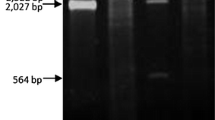Abstract
Fusarium circinatum Nirenberg & O’Donnell (teleomorph = Gibberella circinata) is the causal agent of pitch canker disease of pines. Since 2004 it has been present in Europe, particularly in northern Spain, affecting P. radiata and P. pinaster in plantations and nurseries. The disease has now also spread to other European countries, including France, Italy and Portugal. In this report, we describe three novel members of the genus Mitovirus from a Spanish isolate of F. circinatum: Fusarium circinatum mitovirus 1 (FcMV1), FcMV2-1 and FcMV2-2. Using a mitochondrial translation table, the complete 2419-bp genome of FcMV1 encodes an RNA-dependent RNA polymerase of 731 amino acids (GC-content ca 30 %). The partial genomes of FcMV2-1 and FcMV2-2 (2193 and 1973 bp, respectively) share ca 48 % RdRp sequence similarity at the aa level and might be regarded as conspecific, while FcMV1 is clearly distinct, showing 32-35 % polymerase similarity to the other strains. However, FcMV1 shared 46 % protein-level similarity with Thielaviopsis basicola mitovirus. This is the first study to report viruses in F. circinatum, as well as the first time that mitovirus genome sequences are described from Fusarium spp.

Similar content being viewed by others
References
Botella L, Tuomivirta TT, Diez JJ, Hantula J (2012) Occurrence of two different species of mitoviruses in the European race of Gremmeniella abietina var. abietina, both hosted by the genetically unique Spanish population. Fungal Biol 116:872–882
Cho WK, Lee KM, Yu J, Son M, Kim KH (2013) Insight into mycoviruses infecting Fusarium species. Adv Virus Res 86:273–288
Chu YM, Jeon JJ, Yea SJ, Kim YH, Yun SH, Lee YW, Kim KH (2002) Double-stranded RNA mycovirus from Fusarium graminearum. Appl Environ Microb 68:2529–2534
Deng F, Xu R, Boland GJ (2003) Hypovirulence-associated double-stranded RNA from Sclerotinia homoeocarpa is conspecific with Ophiostoma novo-ulmi mitovirus 3a-Ld. Phytopathology 93:1407–1414
Gordon TR, Storer AJ, Wood DL, Monterey N, Nelson R (2001) The pitch canker epidemic in California. Plant Dis 85:1128–1139
Hillman BI, Cai G (2013) The family Narnaviridae: simplest of RNA viruses. Adv Virus Res 86:149–176
Hillman BI, Esteban R (2011) Family Narnaviridae. In: King AMQ et al (eds) Virus taxonomy: Ninth Report of the International Committee on taxonomy of viruses. Elsevier, New York, pp 1055–1060
Heaton LA, Leslie JF (2004) Double-stranded RNAs associated with Fusarium proliferatum mitochondria. Mycol Prog 3:193–198
Hepting GH, Roth ER (1946) Pitch Canker, a new disease of some southern pines. J Forest 44:742–744
Lambden PR, Cooke SJ, Caul EO, Clarke IN (1992) Cloning of noncultivatable human rotavirus by single primer amplification. J Virol 66:1817–1822
Martínez-Álvarez P, Alves-Santos FM, Diez JJ (2012) In vitro and in vivo interactions between Trichoderma viride and Fusarium circinatum. Silva Fenn 46:303–316
Morris TJ, Dodds JA (1979) Isolation and analysis of double-stranded-RNA from virus-infected plant and fungal tissue. Phytopathology 69:854–858
Tamura K, Peterson D, Peterson N, Stecher G, Nei M, Kumar S (2011) MEGA5: Molecular Evolutionary Genetics Analysis using maximum likelihood, evolutionary distance, and maximum parsimony methods. Mol Biol Evol 28:2731–2739
Tuomivirta TT, Uotila A, Hantula J (2002) Two independent double-stranded RNA patterns occur in the Finnish Gremmeniella abietina var. abietina type A. Forest Pathol 32:197–205
Vainio EJ, Kerio S, Hantula J (2011) Description of a new putative virus infecting the conifer pathogenic fungus Heterobasidion parviporum with resemblance to Heterobasidion annosum P-type partitivirus. Arch Virol 156:79–86
Acknowledgments
We are grateful to D. de Vega, M. Kashif, M.-L. Santanen, and S. Sarsila for their help in the laboratory work. This research was supported by the Ministry of Economy and Competitiveness (Project: AGL2012-39912), a short-term scientific mission of the EU COST Action FP1002 (PERMIT), and by grants provided by the University of Valladolid, the Academy of Finland (decision number 251193), and the Finnish Forest Research Institute.
Author information
Authors and Affiliations
Corresponding author
Additional information
Nucleotide sequence data reported in this study are available in the GenBank under the accession numbers KF803546-48.
Electronic supplementary material
Below is the link to the electronic supplementary material.
Rights and permissions
About this article
Cite this article
Martínez-Álvarez, P., Vainio, E.J., Botella, L. et al. Three mitovirus strains infecting a single isolate of Fusarium circinatum are the first putative members of the family Narnaviridae detected in a fungus of the genus Fusarium . Arch Virol 159, 2153–2155 (2014). https://doi.org/10.1007/s00705-014-2012-8
Received:
Accepted:
Published:
Issue Date:
DOI: https://doi.org/10.1007/s00705-014-2012-8




